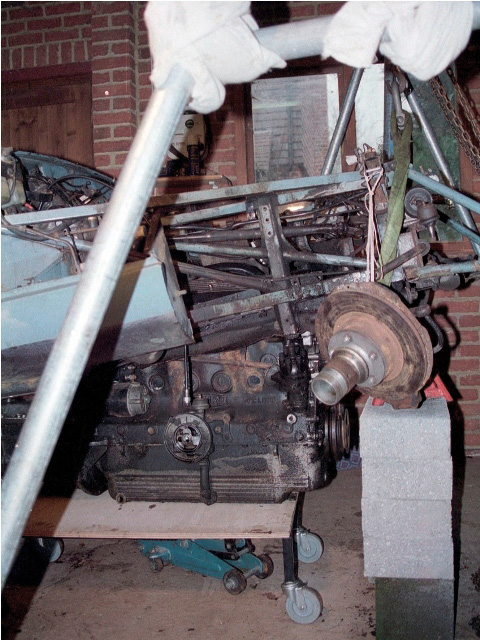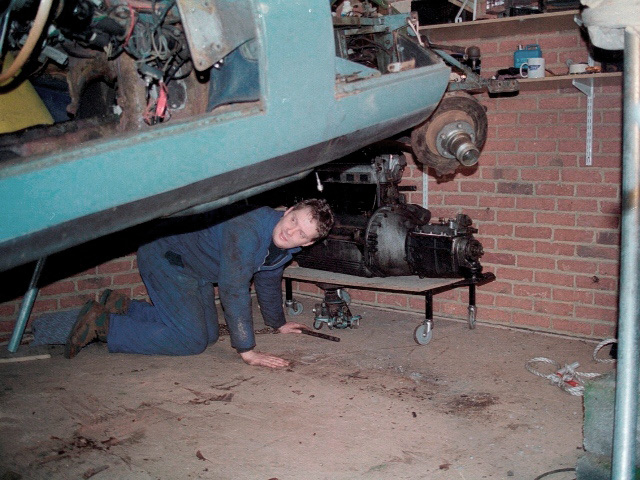The two tried and tested methods for the engine removal are either lifting it out from above or lowering it onto a trolley and then lifting the body sufficiently until the engine is clear of the sub frames. Although I’ve heard of people, doing full restorations, who have lowered the engine onto a trolley and then removed the surrounding engine sub frames.
The difficulty with the removal from above is that the engine and gearbox come out together as a single unit and this requires it to be tilted at the same time as it is being lifted clear. I didn’t have a controllable method of tilting and wasn’t too keen on having such a weighty item dangling at such a height.
 I was also doubtful that my home-made lifting frame, scaffolding cut to make a cross beam supported by A-frames, could raise the engine/gearbox unit to a sufficient height to clear the sub frames. So my only real option was to drop the engine.
I was also doubtful that my home-made lifting frame, scaffolding cut to make a cross beam supported by A-frames, could raise the engine/gearbox unit to a sufficient height to clear the sub frames. So my only real option was to drop the engine.
The bottom out approach is documented in the Haynes manual and required the removal of all the engine ancillaries, the exhaust and inlet manifolds, alternator, oil filter etc. Once these had been removed I was then ready to lower the engine. Gulp! So far, so good.
At this point I must have taken leave of my senses when making some key decisions and the removal process descended into more of a farce!
 I had some 1″ square Dexion speedframe lying around which included a set of castor wheels so I set about making a makeshift trolley. I’d lower the engine and gearbox on to the trolley, lift the car and then pull clear.
I had some 1″ square Dexion speedframe lying around which included a set of castor wheels so I set about making a makeshift trolley. I’d lower the engine and gearbox on to the trolley, lift the car and then pull clear.
The first issues were the length of the 3-pronged corner connectors and that a length of 1″ square would be required between the connector and the castors. This resulted in a considerably higher platform that I’d originally envisaged.
The knock on effect was that, not only would I have to raise the front of the car even further, I would have to raise the rear of the car to reduce the body angle when the front was raised. This would allow the engine & gearbox to be dropped without hitting the sub frames. At this stage I should have reconsidered my approach to how I was dropping the engine.
The car was already supported on axle stands so once the ancillaries had been removed, the hoist could be used to lower the engine onto the waiting trolley. The castors were already showing signs of giving way, as can be seen in the photo above! I really should have reconsidered whether it was wise to continue. However, again, I ploughed on. Dooh!
 The front and rear were then raised alternately, supported by axle stands on building blocks. The rear was just about within the range of my trolley jacks but the front needed to be lifted via the lifting frame.
The front and rear were then raised alternately, supported by axle stands on building blocks. The rear was just about within the range of my trolley jacks but the front needed to be lifted via the lifting frame.
Once the front sub-frame was clear of the engine, the lifting frame was used to take the full weight of the front of the bodyshell. The supporting blocks were then removed to provide an exit route for my wobbly trolley. The trolley castors didn’t approve of being moved and their jaunty angle worsened severely as the trolley was delicately pulled clear!
At this stage I would have been in all sorts of problems had the trolley collapsed “mid-extraction” as the only lifting gear I had was in used supporting the bodyshell!
|
|
|
I did have to realign the trolley legs several times, taking the weight by an extended crowbar. It was very close but fortunately the trolley lasted just long enough to pull the engine clear. It was then mounted on a proper engine stand.
|
|
|
On a positive note, the lesson learnt for the rebuild is to use a more substantial trolley which is as low to the ground as possible and to have a backout plan in case something does go wrong. Even with the self-induced problems, I still think dropping the engine is the way to go!





Sorry, the comment form is closed at this time.